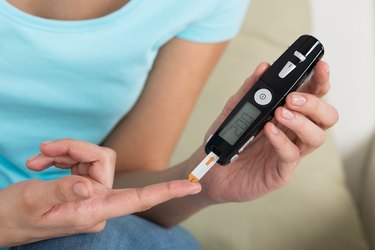
Blood sugar, or glucose, serves as the fuel your body uses to generate energy. The level of glucose in your blood remains fairly stable, slightly rising after eating and declining a small amount between meals or after exercising. Blood glucose can be measured in many ways. Some tests measure glucose directly, while others measure the amount of glucose attached to a specific protein.
Fasting and Premeal Blood Glucose Levels
Video of the Day
The amount of glucose in the blood varies, depending on when you last ate. A fasting blood glucose level after at least 8 hours without caloric intake in a healthy, nondiabetic adult typically ranges from 70 to 99 mg/dL, according to the American Diabetes Association (ADA). People with a fasting blood glucose of 100 to 125 mg/dL are considered prediabetic, meaning the body's handling of glucose is impaired but not yet to the point of warranting a diagnosis of diabetes.
Video of the Day
A fasting blood glucose of 126 mg/dL or greater typically indicates diabetes, according to ADA criteria. Among people diagnosed with diabetes who are not pregnant, the ADA recommends a target fasting or premeal blood sugar level of 80 to 130 mg/dL.
Postprandial and Oral Glucose Tolerance Levels
As the blood glucose level typically increases after eating, testing after a meal -- known as a postprandial glucose level -- provides information about the body's capacity to maintain a healthy blood sugar level when challenged with a caloric load. Blood glucose levels usually peak 1 to 2 hours after beginning a meal, depending largely on the amount of carbohydrates, proteins and fat in the meal. Among healthy, nondiabetic adults a normal postprandial glucose level 2 hours after a meal is less than 140 mg/dL. For people with diabetes, the ADA generally recommends a peak postprandial glucose of less than 180 mg/dL, although the target level may vary among individuals.
When screening for diabetes, a test called an oral glucose tolerance test (OGTT) may be used. This test involves consuming a measured amount of glucose, usually 75 grams, and measuring the blood sugar level at specific time points for up to 3 hours. According to ADA, a normal glucose level at the 2-hour time point during an OGTT is less than 140 mg/dL. Values of 140 to 199 mg/dL at this time point indicate impaired glucose tolerance, or prediabetes. A blood glucose of 200 mg/dL or greater at the 2-hour time point with an OGTT is diagnostic for diabetes.
Glycated Hemoglobin A1C
The A1C blood test -- more specifically called glycated hemoglobin A1C -- assesses the blood sugar level over time. Instead of determining the amount of blood sugar present at the time of the test, the A1C test determines the average blood sugar level over an extended period, typically the past 3 months. This is done by measuring glycated hemoglobin, which is formed when glucose attaches to the hemoglobin protein found in red blood cells. The percent of hemoglobin with sugar bound to it correlates to the amount of sugar in the bloodstream over time. The more sugar in the blood, on average, the higher the percentage of glycated hemoglobin in the red blood cells.
The normal range for A1C among healthy, nonpregnant adults is 4.0 to 5.6 percent. These values correlate to According to ADA criteria, A1C values of 5.7 to 6.4 percent typically indicate prediabetes, and values of 6.5 percent or greater are diagnostic for diabetes.
Estimated Average Glucose
The estimated average glucose (eAG) value is calculated from the A1C level to give an average blood glucose level over roughly the past 3 months. The calculation converts the A1C result from percent glycated hemoglobin to the estimated average blood glucose in mg/dL. This value is most commonly used by people with diabetes to help manage their glucose levels. However, it's important not to compare eAG to fasting or postprandial blood sugar levels because eAG is an average of glucose level over time.
The eAG for normal, prediabetes and diabetes A1C levels are: - Normal (4.0 to 5.6 percent A1C) -- 68 to 114 mg/dL - Prediabetes (5.7 to 6.4 percent A1C) -- 117 to 137 mg/dL - Diabetes (6.5 percent A1C or greater) -- 140 mg/dL or more
Reviewed and revised by: Tina M. St. John, M.D.
Is this an emergency? If you are experiencing serious medical symptoms, please see the National Library of Medicine’s list of signs you need emergency medical attention or call 911.